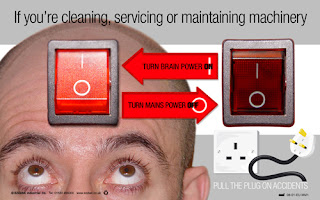 |
| 1 |
 |
| 2 |
 |
| 3 |
Updated October 2014
According to the HSE, there are more than 1,000 electrical accidents in every year in the UK. Most of these accidents result in shocks and/or burns, but around 25 are fatal.
The human body conducts electricity, just like a wire. Even being exposed to a low current of 50 volts can cause muscle spasms and inhibit your heartbeat and breathing.
Here are ten tips to pull the plug on electrical accidents.
1. No experience, no way!
Electricity can be dangerous, which is why electrical repairs maintenance and modifications must only be carried out by a suitably qualified and experienced person.
Electricity can be dangerous, which is why electrical repairs maintenance and modifications must only be carried out by a suitably qualified and experienced person.
2. Never use defective equipment
Inspect plugs, cables and appliances regularly and make sure they are free from damage, cracks, burn marks and stains. Ensure cables have no internal wires showing and tool handles are properly insulated with no cracks or damage. Always tag defective equipment and report it for maintenance.
Inspect plugs, cables and appliances regularly and make sure they are free from damage, cracks, burn marks and stains. Ensure cables have no internal wires showing and tool handles are properly insulated with no cracks or damage. Always tag defective equipment and report it for maintenance.
3. Never rely on temporary repairs
Never attempt quick fixes. Covering cracks or exposed wires with insulating tape won't solve an underlying problem and the equipment could still be dangerous to use.
Never attempt quick fixes. Covering cracks or exposed wires with insulating tape won't solve an underlying problem and the equipment could still be dangerous to use.
4. Never work on live machinery
Always lock out and tag out the power when cleaning, removing jams and carrying out routine maintenance. If you fail to do so the machine could start up again unexpectedly and cause a serious accident.
Always lock out and tag out the power when cleaning, removing jams and carrying out routine maintenance. If you fail to do so the machine could start up again unexpectedly and cause a serious accident.
5. Never mix electricity and water
Electricity and water can be a fatal combination. Keep them apart and never use water extinguishers to put out electrical fires.
Electricity and water can be a fatal combination. Keep them apart and never use water extinguishers to put out electrical fires.
6. Never overload plug sockets
Overloaded sockets can cause fires. There is a limit to how many amps multi-plug adaptors and extension leads can handle, so make sure you stay within safe restrictions.
Overloaded sockets can cause fires. There is a limit to how many amps multi-plug adaptors and extension leads can handle, so make sure you stay within safe restrictions.
7. Never leave trailing cables
Wires left across walkways create potentially dangerous trip hazards. Keep all cables neat and tidy – tape them down if necessary.
Wires left across walkways create potentially dangerous trip hazards. Keep all cables neat and tidy – tape them down if necessary.
8. Make sure equipment is suitable
Make sure electrical equipment is suitable for the task and the electricity supply before use.
Make sure electrical equipment is suitable for the task and the electricity supply before use.
9. Use electric heaters with care
Position electric heaters sensibly, away from flammables, combustibles and sources of water or ignition. Ideally plug them into a designated socket and do not leave trailing cables. Remember to switch them off when not in use.
Position electric heaters sensibly, away from flammables, combustibles and sources of water or ignition. Ideally plug them into a designated socket and do not leave trailing cables. Remember to switch them off when not in use.
10. Be aware of overhead or underground cables
When working at height or digging below ground, beware of any electric cables in the vicinity and avoid any accidental contact.
When working at height or digging below ground, beware of any electric cables in the vicinity and avoid any accidental contact.
Kodiak has a variety of posters covering electrical issues. If you would like to find out more about how our posters can help you manage electrical safety risks in your operation, please get in touch with us.

Nice tips, they are really useful. Thanks for posting it here so that everyone aware on this kind of situation. And if you can't fix some of your electrical problems, then this Accredited Energy Auditors in Sydney will help you. You can visit their website here to know more about their services.
ReplyDelete